Never miss another geomagnetic storm. Sign up for Space Weather Alerts and you'll receive a text message when magnetic storms erupt. Aurora tour guides and professional astronomers use this service. You can, too! | | |
ANOTHER CME JUST ARRIVED: Unexpectedly, a CME hit Earth's magnetic field today, Aug. 30th at 1920 UT; it was a glancing blow. This appears to be yet another CME launched by departing sunspot AR3088 near the edge of the Earth strike zone. Minor G1-class geomagnetic storms are possible in response to its arrival. Aurora alerts: SMS Text.
ARTEMIS UPDATE LATER TODAY: NASA will hold a teleconference at 6 p.m. EDT on Tuesday, Aug. 30th, to discuss the upcoming launch of the Artemis I moon rocket. The first attempt on Monday was scrubbed when a hydrogen fuel line failed to fully open and properly cool one of the four main engines. NASA hopes to solve the problem in time for a new launch window on Sept. 2nd. Audio of the teleconference will stream live online at https://www.nasa.gov/live.
THE LEANING TOWER OF PLASMA: For days, astronomers around the world have been monitoring a tower of plasma sticking out of the sun's southern hemisphere. Philippe Tosi sends this Aug. 30th photo from Nîmes, France:
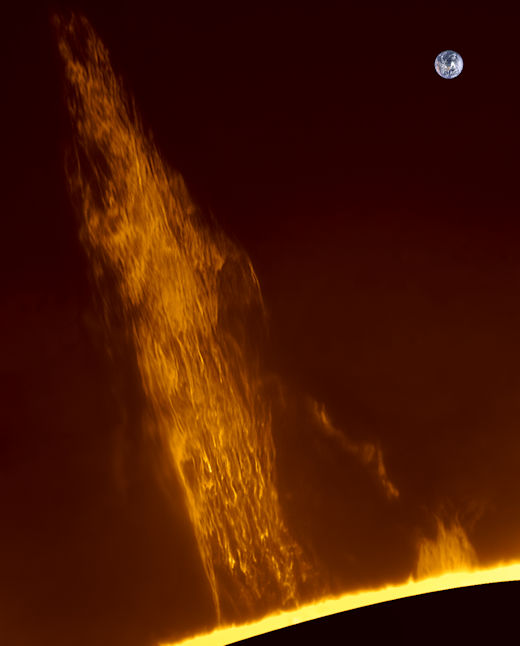
The structure, twisting like a tornado 20 times taller than Earth, has persisted longer than most prominences do, attracting plenty of attention. Everyone can put away their telescopes now. The sun just ejected the tower into space. Watch this movie from NASA's Solar Dynamics Observatory.
Realtime Space Weather Photo Gallery
Free: Spaceweather.com Newsletter
EARTH JUST DODGED A LOT OF CMES: It seemed like sunspot AR3088 would never stop exploding. Over the past four days, the strangely-magnetized active region produced more than a dozen M-class solar flares:

Each X-ray peak in the graph above produced a corresponding shortwave radio blackout on Earth. No part of our planet was untouched.
More than half of the explosions also produced a coronal mass ejection (CME). Earth dodged them all. Only one and maybe two delivered glancing blows of no consequence. All the rest sailed harmlessly into space.
The simple reason why: AR3088 was never facing Earth. Most of the explosions occured while the sunspot was approaching or even rounding the sun's western limb.
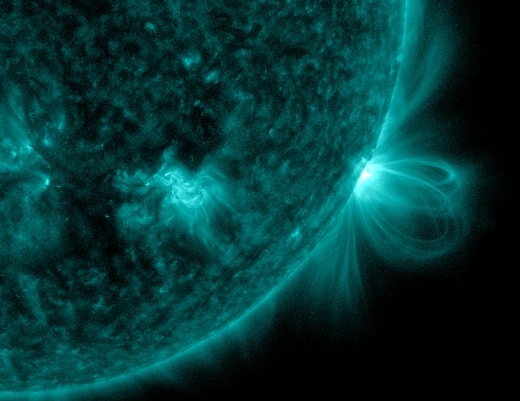
This movie from NASA's Solar Dynamics Observatory is a good example. It shows a flare from AR3088 on Aug. 29th partially eclipsed by the edge of the sun. The explosion registered M9 on GOES satellite X-ray sensors, but the uneclipsed flare was probably much stronger--perhaps even an X-flare.
If the sunspot had been facing us, we might now be experiencing strong geomagnetic storms with spectacular low-latitude auroras. Maybe next time...
Realtime Aurora Photo Gallery
Free: Spaceweather.com Newsletter
"I LOVE YOU MORE" OPAL: Nothing says "I love you" like jewelry from space. On June 3, 2022, this sterling silver opal pendant hitched a ride on an Earth to Sky Calculus cosmic ray research balloon. At the apex of the flight it floated 101,326 feet above the Sierra Nevada mountains of central California:
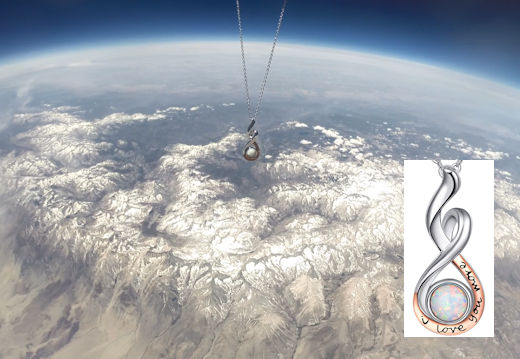
You can have it for $142.95. The opal's infinity wrap is engraved with "I Love You More." It's the perfect birthday, anniversary or (never too early!) Christmas gift for that special someone who loves space. Each pendant comes with a greeting card showing the pendant in flight and telling the story of its trip to the stratosphere and back.
Far Out Gifts: Earth to Sky Store
All sales support hands-on STEM education
Realtime Noctilucent Cloud Photo Gallery
Free: Spaceweather.com Newsletter
Every night, a network of
NASA all-sky cameras scans the skies above the United States for meteoritic fireballs. Automated software maintained by NASA's Meteoroid Environment Office calculates their orbits, velocity, penetration depth in Earth's atmosphere and many other characteristics. Daily results are presented here on Spaceweather.com.
On Aug 30, 2022, the network reported 13 fireballs.
(13 sporadics)
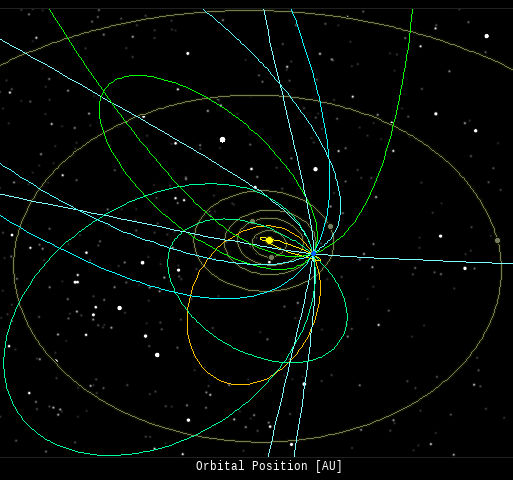
In this diagram of the inner solar system, all of the fireball orbits intersect at a single point--Earth. The orbits are color-coded by velocity, from slow (red) to fast (blue). [Larger image] [movies]
Potentially Hazardous Asteroids (
PHAs) are space rocks larger than approximately 100m that can come closer to Earth than 0.05 AU. None of the known PHAs is on a collision course with our planet, although astronomers are finding
new ones all the time.
On August 30, 2022 there were 2288 potentially hazardous asteroids.
 |
Recent & Upcoming Earth-asteroid encounters: | Asteroid | Date(UT) | Miss Distance | Velocity (km/s) | Diameter (m) |
| 2022 QP4 | 2022-Aug-26 | 3.7 LD | 7.7 | 13 |
| 2022 QP6 | 2022-Aug-27 | 2 LD | 13.6 | 14 |
| 2022 QQ4 | 2022-Aug-27 | 15.5 LD | 7.2 | 32 |
| 2022 QP3 | 2022-Aug-28 | 14.4 LD | 7.9 | 31 |
| 2022 QX4 | 2022-Aug-29 | 4.8 LD | 8.8 | 41 |
| 2017 BU | 2022-Aug-29 | 15.8 LD | 7 | 32 |
| 2022 QX1 | 2022-Aug-31 | 5.4 LD | 21.1 | 42 |
| 2022 QZ6 | 2022-Aug-31 | 3.3 LD | 11.2 | 36 |
| 2022 QS7 | 2022-Aug-31 | 13.1 LD | 7.7 | 21 |
| 2022 QT7 | 2022-Sep-01 | 1.2 LD | 7.7 | 6 |
| 2021 CQ5 | 2022-Sep-01 | 8.7 LD | 13.5 | 7 |
| 2022 QB2 | 2022-Sep-01 | 10.3 LD | 15.9 | 34 |
| 2022 QN5 | 2022-Sep-02 | 2.4 LD | 13.5 | 22 |
| 2022 QJ7 | 2022-Sep-05 | 14.8 LD | 12 | 25 |
| 2022 QU5 | 2022-Sep-05 | 19.2 LD | 7.1 | 31 |
| 2022 QC7 | 2022-Sep-06 | 12.2 LD | 9.1 | 22 |
| 2022 QF2 | 2022-Sep-11 | 19.1 LD | 8.4 | 44 |
| 2008 RW | 2022-Sep-12 | 17.5 LD | 10.2 | 98 |
| 2020 PT4 | 2022-Sep-15 | 18.8 LD | 10.8 | 39 |
| 2022 QD1 | 2022-Sep-16 | 19.4 LD | 9.5 | 72 |
| 2016 HF2 | 2022-Sep-29 | 19.2 LD | 5.6 | 21 |
| 2018 ER1 | 2022-Oct-02 | 14.7 LD | 4 | 27 |
| 2018 VG | 2022-Oct-05 | 18.5 LD | 6.7 | 12 |
| 2021 TJ10 | 2022-Oct-06 | 19.6 LD | 8.1 | 6 |
| 2006 SG7 | 2022-Oct-07 | 16.7 LD | 18.4 | 93 |
| 2013 TJ6 | 2022-Oct-07 | 11.7 LD | 14.4 | 32 |
| 2013 SL20 | 2022-Oct-14 | 6.2 LD | 12.1 | 45 |
| 2020 TO2 | 2022-Oct-15 | 1.4 LD | 12.6 | 18 |
| 2020 BD | 2022-Oct-16 | 12.1 LD | 11.4 | 20 |
| 2022 QM6 | 2022-Oct-17 | 19.8 LD | 4.2 | 69 |
| 2016 TH94 | 2022-Oct-25 | 19.1 LD | 13.5 | 43 |
| 2019 AN5 | 2022-Oct-27 | 20 LD | 6.8 | 213 |
Notes: LD means "Lunar Distance." 1 LD = 384,401 km, the distance between Earth and the Moon. 1 LD also equals 0.00256 AU. | | Cosmic Rays in the Atmosphere |
SPACE WEATHER BALLOON DATA: Almost once a week, Spaceweather.com and the students of Earth to Sky Calculus fly space weather balloons to the stratosphere over California. These balloons are equipped with sensors that detect secondary cosmic rays, a form of radiation from space that can penetrate all the way down to Earth's surface. Our monitoring program has been underway without interruption for 7 years, resulting in a unique dataset of in situ atmospheric measurements.
Latest results (July 2022): Atmospheric radiation is decreasing in 2022. Our latest measurements in July 2022 registered a 6-year low:
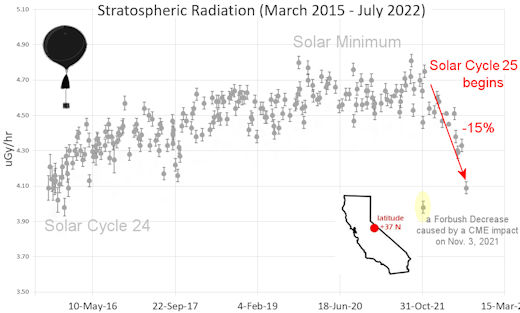
What's going on? Ironically, the radiation drop is caused by increasing solar activity. Solar Cycle 25 has roared to life faster than forecasters expected. The sun's strengthening and increasingly tangled magnetic field repels cosmic rays from deep space. In addition, solar coronal mass ejections (CMEs) sweep aside cosmic rays, causing sharp reductions called "Forbush Decreases." The two effects blend together to bring daily radiation levels down.
.Who cares? Cosmic rays are a surprisingly "down to Earth" form of space weather. They can alter the chemistry of the atmosphere, trigger lightning, and penetrate commercial airplanes. According to a study from the Harvard T.H. Chan school of public health, crews of aircraft have higher rates of cancer than the general population. The researchers listed cosmic rays, irregular sleep habits, and chemical contaminants as leading risk factors. A number of controversial studies (#1, #2, #3, #4) go even further, linking cosmic rays with cardiac arrhythmias and sudden cardiac death.
Technical notes: The radiation sensors onboard our helium balloons detect X-rays and gamma-rays in the energy range 10 keV to 20 MeV. These energies span the range of medical X-ray machines and airport security scanners.
Data points in the graph labeled "Stratospheric Radiation" correspond to the peak of the Regener-Pfotzer maximum, which lies about 67,000 feet above central California. When cosmic rays crash into Earth's atmosphere, they produce a spray of secondary particles that is most intense at the entrance to the stratosphere. Physicists Eric Regener and Georg Pfotzer discovered the maximum using balloons in the 1930s and it is what we are measuring today.
| | The official U.S. government space weather bureau |
| | The first place to look for information about sundogs, pillars, rainbows and related phenomena. |
| | Researchers call it a "Hubble for the sun." SDO is the most advanced solar observatory ever. |
| | 3D views of the sun from NASA's Solar and Terrestrial Relations Observatory |
| | Realtime and archival images of the Sun from SOHO. |
| | information about sunspots based on the latest NOAA/USAF Active Region Summary |
| | current counts of failed and deployed Starlink satellites from Jonathan's Space Page |
| | Authoritative predictions of space junk and satellite re-entries |
| | from the NOAA Space Environment Center |
| | fun to read, but should be taken with a grain of salt! Forecasts looking ahead more than a few days are often wrong. |
| | from the NOAA Space Environment Center |
| | the underlying science of space weather |
 | BestCSGOGambling is the best site for everything related to CSGO gambling on the web |
 | To find reviews of new online casino sites in the UK try The Casino DB where there are hundreds of online casino reviews complete with bonuses and ratings. Alternatively, Online-Casinos.xyz is another massive directory of online casinos listing sites for the UK and Worldwide. Casinos that offer Rupees for bonuses are very generous to Indian players. Find the best online casinos in India at AllCasinos.in Looking for a new online casino? Try Casimpo the new site dedicated to making online casino simple, or check out the new Avenger Slots Casino and Ace Online Casino with over 500 online slots and casino games. |
 | One of the most popular casino games is the Book Of Dead Slot based on ancient Egyptian text, you can find all the casinos with spins at bookofdeadslotsites.com. |
 | When looking for casinos to play online when the weather is bad, you can try casino online trucchi for Italian games. If you are not from Finland you can try the Swedish page Svenska casino online to find suitable games, check out svenskacasinoonline.net. Always check your local laws before playing with real money. |
 | Looking for sports betting companies not registered on GamStop? CasinoGap has presented a list of sites not on GamStop available for UK players. Check and bet online! Would you like to bet at sites not using GamStop? Look at a list of NonStopCasino sites for online betting that aren't on GamStop. Top-rated bookmakers ever! |
| | These links help Spaceweather.com stay online. Thank you to our supporters! |
| | | | | | |

